
PXDTCE
A
D
I
B
EF
J
G
C
H
+-
12 V
TAMP
NC
ALL
NC
MASK
NC
NO
SI
A
A
B
B
C
OK
OK
NO
30°
80cm
0
0
0
2m
2m
4m
4m
2,1m
1m
1m
1m
6m
6m
8m
8m
10m
10m
12m
12m
0
0
2m 4m
4m
3m
2m
1m
6m 8m 10m 12m
4
F
G
83
E
A
B
C
E
D
A
A
B
FH
K
K
L
Q
R
I
I
N
OP
P
G
CD H J
M
E
1
2
F
FA00501M4A
FA00501M4A - ver. 1 - 04/2017
Avvertenze generali
Importanti istruzioni per la sicurezza delle
persone: LEGGERE ATTENTAMENTE! • L’instal-
lazione, la programmazione, la messa in servi-
zio e la manutenzione devono essere eettuate
da personale qualificato ed esperto e nel pieno
rispetto delle normative vigenti. • Indossare
indumenti e calzature antistatiche nel caso
di intervento sulla scheda elettronica. • Con-
servare queste avvertenze. • Togliere sempre
l’alimentazione elettrica durante le operazioni
di pulizia o di manutenzione. • Il prodotto deve
essere destinato solo all’uso per il quale è sta-
to espressamente studiato. Ogni altro uso è da
considerarsi pericoloso. • Il costruttore non può
comunque essere considerato responsabile per
eventuali danni derivanti da usi impropri, erronei
ed irragionevoli.
Descrizione
Rivelatore ad eetto tenda a doppia tecno-
logia, realizzato con sezione ad infrarossi
passivi e sezione a microonda. Funzione di
antimascheramento di entrambe le sezioni
segnalata tramite apposita uscita a relè. Por-
tata 12 m. Regolazione della portata tramite
trimmer e dip switch. Installazione da interno
ed esterno, particolarmente indicato per la
protezione di facciate esterne. Utilizzato con
parzializzatore PXDTCP risulta immune agli
animali di piccola taglia. Provvisto di circui-
to per memoria di allarme. Ingresso TC per
inibizione rivelatore a centrale disinserita.
Completo di staa angolare per fissaggio a
parete su lato destro o sinistro e tettuccio
antipioggia.
Descrizione delle parti
A Morsettiera
B Dip-switch
C Microonda
D Potenziometro
E Lente IR
F LED blu: Microonda
7 LED rosso: Allarme
H LED giallo: IR
Dati tecnici
Tipo PXDTCE
Alimentazione (V DC) 12
Assorbimento max (mA) 32
Assorbimento a riposo (mA) 20
Frequenza microonda (Ghz) 24
Tempo d'allarme (s) 3
Portata contatto d'allarme a 24
V (mA) 100
Portata contatto tamper a 30
V (mA) 100
Portata contatto antimask a 48
V (mA) 300
MTBF teorico (h) 120.000
Portata (m) 12
Dimensioni (mm) 110x44x46
Temperatura di funzionamento
( °C) -10/+55
Conformità normativa: EN50131-2-4, Grado
2, Classe IV
Morsettiera
IINPUT: ingresso riconoscimento im-
pianto inserito/disinserito
+ -/12 V Ingresso alimentazione 12 V
NC/TAMP Contatto tamper NC
NC/ALL Relè allarme NC
NC/MASK Relè Antimask NC
Legenda LED
LED acceso, LED spento, LED lam-
peggiante
* Visualizzazioni in stato di memoria
Stato blu rosso giallo
PIR+MW *
Antimask *
Dip-switch
DIP1-Antimask della microonda e infra-
rosso
ON Attivazione OFF Disattivazione
La funzione antimask è utile per determinare
eventuali mascheramenti della microonda e/o
della lente del PIR.
La funzione antimask si abilita solo dopo aver
chiuso il frontalino. Una volta posizionato il
coperchio, è necessario attendere l'autocali-
brazione per circa 60 sec. (i led lampegge-
ranno alternativamente). Durante il tempo di
calibrazione non bisogna muoversi o porre
oggetti davanti al sensore.
Al termine il sensore sarà pronto al funzio-
namento.
Se la funzione antimask è abilitata e il dip 2
è in modalità INTERNA, la sensibilità risulta
essere massima. Se la funzione antimask è
abilitata e il dip 2 è in modalità ESTERNA, la
sensibilità è ottimizzata su perturbazioni at-
mosferiche.
DIP2-DIP3
1 ON OFF
Installazione interna, con
funzione ‘attraversamento’
(massima velocità di rile-
vazione)
2
ON
ON Installazione interna, con
funzione ‘avvicinamento’
3 OFF OFF
Installazione esterna, con
funzione ‘attraversamento’
4 OFF
ON
Installazione esterna, con
funzione ‘avvicinamento’
(minima velocità di rileva-
zione)
DIP4-Esclusione Antimask della microonda
ON Disattivazione OFF Attivazione
Questa funzione è utile per installazioni che
presentano corpi solidi in movimento nelle
immediate vicinanze che potrebbero genera-
re allarmi di mascheramento.
DIP5-Attivazione/disattivazione LED
ON Disattivazione (*)
OFF Attivazione
(*) La visualizzazione della memoria d'allarme
resta abilitata.
Potenziometro
Regola la portata della microonda. Regolata la
microonda il sensore adeguerà in automatico
anche l’infrarosso.
Funzioni con linea input
Queste funzioni vengono attivate/disattivate
tramite l’inserimento/disinserimento dell’im-
pianto.
A tale proposito viene considerato:
12 V sull’ingresso INPUT = impianto disinserito
0 V sull’ingresso INPUT = impianto inserito
Abilitazione remota dei LED
Al disinserimento dell’impianto, il sensore si
predispone alla riabilitazione delle visualizza-
zioni di rilevazione.
Le visualizzazioni verranno riabilitate alla pri-
ma rilevazione eettuata, e rimarranno attive
per 30 s.
Memorie
Al disinserimento dell’impianto, verrà visua-
lizzata tramite le segnalazioni dei LED la me-
moria del primo allarme avvenuto. La memo-
ria verrà resettata al successivo inserimento
dell’impianto.
Ritardo della memoria per utilizzo in zone
temporizzate
Tempo di uscita: gli allarmi che si verificano
entro i primi 30 s dall’ inserimento dell’im-
pianto vengono cancellati.
Tempo di ingresso: gli allarmi che si verificano
30 s prima del disinserimento dell’impianto
vengono cancellati.
Installazione B
Aprire il sensore svitando la vite G e smon-
tare il fondo intermedio e la scheda dal fondo.
A muro o con staa angolare
Incidere le sedi 9 e J presenti sul fondo K
e far passare i cavi attraverso l'apertura cavo
presente nel fondo.
Per installazioni a muro fissare il fondo con le
apposite viti tramite le sedi 9 e J.
Per installazioni con staa angolare M, fissa-
re la staa direttamente a muro utilizzando le
appositi viti N e O e successivamente fissa-
re il fondo K alla staa utilizzando i fori 9 e
J. Riavvitare la scheda al fondo e procedere
con i collegamenti. La staa angolare può
essere montata con verso destro o sinistro.
Con snodo PXDTCS (opzionale) P
Non è consigliabile utilizzare lo snodo per in-
stallazioni da esterno.
Lo snodo permette di orientare il sensore di
± 45° sul piano verticale e di + 30° nel piano
orizzontale, nel senso contrario delle frecce di
orientamento Q.
Forare le sedi R S e T e far passare il cavo
attraverso lo snodo e il passacavo T. Posi-
zionare il fondo sullo snodo utilizzando le viti
, orientare lo snodo e chiudere le viti.
Fissare la scheda al fondo e procedere con il
collegamento cavi.
Eseguire i vari settaggi e applicare il filtro
led .
Questo filtro permette di oscurare i led di se-
gnalazione e per nascondere la vite di chiusu-
ra del sensore G.
Consigli per l’installazione
C Evitare che sorgenti luminose di elevata
intensità investano direttamente oppure per
riflessione, il sensore;
D 1 Per protezioni di pareti, evitare che una
zona sensibile dell’Infrarosso si trovi a con-
tatto con il muro.
2 Per ovviare a questo, montare il sensore
distaccato dal muro con le distanze riportate
di seguito
Portata (m) Distanza A (cm)
12 120
8 70
4 35
2 18
3 oppure orientare il sensore utilizzando lo
snodo PXDTCS (opzionale).
E Prediligere installazioni dove ci sia un
muro 1 o un pavimento 2 a delimitare il
campo di rilevazione del sensore.
F Se non è possibile installare il sensore a
muro oppure a pavimento installarlo inclinato
di 30°.
Installazione con PET IMMUNITY
G Qualora ci sia la possibilità di transito di
piccoli animali domestici nella zona protetta,
utilizzare il parzializzatore di lente opzionale
(PXDTCP), posizionandolo sulla lente in modo
da lasciar scoperte solo le due zone superiori.
Il sensore, in questo caso dovrà essere in-
stallato su parete verticale ad un’altezza di
80/140 cm da terra.
Montaggio dell’accessorio PXDTCP H
Inserire l’accessorio B all’interno del fissa-
lente E inserendolo con la fessura rivolta
verso l’alto A e fermato dietro il gancio che
ferma il fissalente E.
Diagramma di rilevazione certificato I
Vista dall’alto;
Vista laterale
Diagramma di rilevazione alla massima
altezza d’installazione J
Il prodotto è conforme alle direttive di riferi-
mento vigenti.
Dismissione e smaltimento. Non disperdere
nell’ambiente l’imballaggio e il dispositivo
alla fine del ciclo di vita, ma smaltirli seguen-
do le norme vigenti nel paese di utilizzo del
prodotto. I componenti riciclabili riportano
simbolo e sigla del materiale.
I DATI E LE INFORMAZIONI INDICATE IN
QUESTO MANUALE SONO DA RITENERSI SU-
SCETTIBILI DI MODIFICA IN QUALSIASI MO-
MENTO E SENZA OBBLIGO DI PREAVVISO. LE
MISURE, SE NON DIVERSAMENTE INDICATO,
SONO IN MILLIMETRI.
ITALIANO

FA00501M4A - ver. 1 - 04/2017
General Precautions
Important people-safety instructions: READ
CAREFULLY! • Installing, programming, com-
missioning and maintenance must only be done
by qualified, expert sta and in full complian-
ce with the applicable law. • Wear anti-static
footwear and clothing when working on the
control board. • Keep these precautions. •
Always cut o the mains power supply before
performing any maintenance or cleaning. • This
product should only be used for the purpose for
which it was explicitly designed. Any other use
is dangerous. • The manufacturer cannot be
held liable for any damage resulting from wron-
gful, improper and unreasonable use.
Description
Dual technology curtain-eect detector,
made with passive infrared section and mi-
crowave section. Anti-masking function of
both sections alerted via the corresponding
relay output. Range 12 m. The range can be
adjusted using trimmers and dip switches.
Installation indoors and outside, particularly
suitable for protecting exterior facades. When
used with the PXDTCP shutter, it is immune
to small animals. Featuring alarm memory
circuit. TC input for detector inhibition when
control unit is o. Complete with angle
bracket for wall mounting on the right or left
side and rain canopy.
Description of parts
A Terminal board
B Dip-switch
C Microwave
D Potentiometer
E IR Lens
F Blue LED: Microwave
7 Red LED: Alarm
H Yellow LED: IR
Technical data
Type PXDTCE
Power supply (V DC) 12
Maximum draw (mA) 32
Absorption when idle (mA) 20
Microwave frequency (Ghz) 24
Alarm time (s) 3
Alarm-contact range at 24 V
(mA) 100
Tamper-contact range at 30 V
(mA) 100
Anti-masking contact range at
48 V (mA) 300
theoretic MTBF (h) 120,000
Range (m) 12
Dimensions (mm) 110x44x46
Operating temperature ( °C) -10/+55
Regulatory compliance: EN50131-2-4, Gra-
de 2, Class IV
Terminal board
IINPUT: input for detecting whether the
system is armed or not
+ -/12 V Input for 12 V power supply
NC/TAMP NC tamper contact
NC/ALL NC alarm relay
NC/MASK NC Anti-masking relay
LED legend
LED is on, LED is o, LED flashes
* Viewings in memory state
State blue red yellow
PIR+MW *
Antimask *
Dip-switch
DIP1-Antimask of the microwave and in-
frared
ON Event OFF Deactivation
The antimasking function is useful to establi-
sh any masking attempts to the microwave
and/or PIR lens.
The antimasking function is enabled only
after the front panel is closed. One the cover
is in place, you will need to wait about 60
seconds for the calibration to complete. (the
LEDs will flash in alternating mode). During
the calibration time, do not move or place any
objects in front of the sensor.
One finished, the sensor will be ready to
operate.
If the antimasking function is enabled and
DIP-switch 2 is on INDOOR mode, the sen-
sitivity will be at maximum level. If the anti-
masking function is enabled and DIP-switch
2 is on OUTDOOR mode, the sensitivity is
optimized for low-pressure weather areas.
DIP2-DIP3
1 ON OFF
Indoor installation, with
'crossing' function (maxi-
mum detection speed)
2
ON
ON Indoor installation, with
'approach' mode function
3 OFF OFF
Outdoor installation with,
'crossing'function
4 OFF
ON Outdoor installation, with
'approach' function (mini-
mum detection speed)
DIP4-Excluding the microwave's anti-
masking
ON Deactivation OFF Event
This function is useful for installations that
have solid moving bodies in the vicinity that
could trigger the antimasking alarms.
DIP5-LED activation/deactivation
ON Deactivation (*) OFF Event
(*) The alarm memory viewing remains
enabled.
Potentiometer
It adjusts the range of the microwave. Once
the microwave is adjusted, the sensor will
automatically also adjust the infrared.
Functions with input line
These functions are activated/deactivated by
arming/disarming the system.
To this end, please consider:
12 V on the INPUT = system disarmed
0V on the INPUT = system armed
Remote LED enabling
When the system is disarmed, the sensor sets
up to restore the detection viewings.
The viewings will be restored to the first
actual detection, and remain active for 30
seconds.
Memories
Once the system is disarmed, the LED alerts
will show the memory of the first detected
alarm. The memory will be reset one the sy-
stem is armed again.
Memory delay for using in timer zones
Exit time: alarms that take place within 30
seconds of the system being armed will be
deleted.
Entry time: alarms that take place 30 seconds
before the system is disarmed will be deleted.
Installing B
Open the sensor by turning the screw G and
remove the midway bottom and the control
board from the bottom.
Wall-mounted or corner brace
Drill the housings 9 and J on the bottom
K run the cables through the cable opening
on the bottom.
When wall-mounting, fasten the bottom by
using the corresponding screws via the hou-
sings 9 and J.
When using a corner brace M, fasten the
brace directly to the wall by using the corre-
sponding screws N and O and then fasten
the bottom K to the brace by using the holes
9 and J. Screw the control board back into
place on the bottom and make the necessary
connections. The corner brace can be moun-
ted to be right-handed or left-handed.
With the optional PXDTCS swivel joint P
It is not advisable to use the swivel joint when
installing externally.
The swivel joint is for turning the sensor ±
45° on the vertical axis and + 30° on the ho-
rizontal axis, in the opposite direction of the
arrows Q.
Drill housings R S and T and run the cable
through the swivel and the cable gland T.
Position the bottom onto the swivel and fit
the screws , turn the swivel and tighten
the screws.
Fasten the control board to the bottom and
make the necessary cable connections.
Make the necessary settings and apply the
LED filter .
This filter lets you mask the alert LEDs and
hide the sensor closing screw G.
Installation advice
C Keep any bright light sources away from
direct contact or from reflecting against the
sensor;
D 1 When protecting walls, prevent any
infrared sensitive areas from coming into
contact contact with the wall.
2 To prevent this, mount the sensor so that
is detached form the wall, by respecting the
distances listed below.
Range (m) Distance A (cm)
12 120
8 70
4 35
2 18
3 or turn the sensor by using the optional
PXDTCS swivel joint.
E Favor installations where there is either a
wall 1 or a floor 2 to demarcate the sen-
sor's field of detection.
F If you cannot install the sensor to a wall or
onto the floor, then install it with a 30° incline.
Installing with PET IMMUNITY
G If any small pets are going to pass through
the protected area, use the optional PXDTCP
lens splitter, by placing it onto the lens so that
only the two upper zones are left bare.
The sensor, in this case, must be installed on
a vertical wall at a height of 80/140 cm from
the ground.
Mounting the PXDTCP accessory H
Fit accessory B into the lens fastener E
making sure the fissure is turned upwards
A and fastened behind the tab that holds the
lens fastener E.
Certified detection diagram I
Top view;
Lateral view
Detection diagram at maximum installa-
tion height J
This product complies with the law.
Decommissioning and disposal. Dispose of
the packaging and the device at the end of
its life cycle responsibly, in compliance with
the laws in force in the country where the
product is used. The recyclable components
are marked with a symbol and the material's
ID marker.
THE DATA PRESENTED IN THIS MANUAL
MAY BE CHANGED, AT ANY TIME, AND WI-
THOUT NOTICE. MEASUREMENTS, UNLESS
OTHERWISE STATED, ARE IN MILLIMETERS.
ENGLISH
Общие правила безопасности
Важные правила техники безопасности:
ПРОЧИТАЙТЕ ВНИМАТЕЛЬНО! • Монтаж,
программирование, ввод в эксплуатацию и
техническое обслуживание должны произ-
водиться квалифицированным и опытным
персоналом в полном соответствии с требо-
ваниями действующих норм безопасности.
• Используйте антистатическую одежду и
обувь при работе с электроникой. • Храни-
те данные инструкции. • Всегда отключайте
электропитание перед выполнением работ по
чистке или техническому обслуживанию си-
стемы. • Это изделие должно использовать-
ся исключительно по своему назначению.
Любое другое применение рассматривается
как опасное. • Фирма-изготовитель снимает
с себя всякую ответственность за ущерб,
нанесенный неправильным, ошибочным или
небрежным использованием изделия.
Описание
Проводной комбинированный извещатель
(СВЧ+ПИК) с зоной обнаружения типа «што-
ра». Для сигнализации обнаружения маски-
рования используется специальный релейный
выход, предусмотренный для обеих секций.
Дальность обнаружения: 12 м. Параметр из-
меняется с помощью регулировки и DIP-пе-
реключателей. Устройство предназначено для
установки внутри или снаружи помещения,
в особенности для защиты фасадов зданий.
При использовании с ограничителем зоны об-
наружения PXDTCP извещатель не реагирует
на мелких домашних животных, что позволяет
избежать ложных срабатываний. Устройство
снабжено платой памяти тревожных состоя-
ний. Вход TC для блокировки извещателя при
выключенной контрольной панели. Извеща-
тель укомплектован угловым кронштейном
для установки на стену с правой или левой
стороны и козырьком.
Основные компоненты
A Клеммная колодка
B Dip-переключатели
C Микроволновый датчик
D Потенциометр
E ИК-линза
F Синий индикатор: микроволновый датчик
7 Красный индикатор: тревога
H Желтый индикатор: ИК
Технические характеристики
Модель PXDTCE
Напряжение электропитания (=В)
12
Макс. потребляемый ток (мA) 32
Потребляемый ток в режиме
ожидания (мА) 20
Частота микроволнового излу-
чения (ГГц) 24
Время работы сигнализации (с)
3
Макс. нагрузка на контакты
сигнализации при 24 В (мA) 100
Макс. нагрузка на контакты
датчика саботажа при 30 В (мA)
100
Макс. нагрузка на контакты
антимаскирования 48 В (мA) 300
Средняя наработка на отказ
(в часах) 120000
Дальность действия (м) 12
Габаритные размеры (мм)
110x44x46
Диапазон рабочих температур (°C)
-10/+55
Соответствует стандарту EN50131-2-4, Класс
2, класс опасности для окружающей среды IV
Клеммная колодка
IINPUT: вход определения включен-
ной/выключенной системы
+ -/12 В Вход электропитания 12 В
NC/TAMP Контакты датчика саботажа
(Н.З.)
NC/ALL
Релейные контакты тревожной
сигнализации, нормально-зам-
кнутые
NC/MASK
Релейные контакты антима-
скирования, нормально-зам-
кнутые
УСЛОВНЫЕ ОБОЗНАЧЕНИЯ ИНДИКАТОРА
индикатор горит, индикатор выключен,
индикатор мигает.
* Индикация из памяти состояний
Статус синий красный желтый
ПИК + СВЧ*
Статус синий красный желтый
Антимаски-
рование *
Dip-переключатель
DIP1 - Обнаружение маскирования
СВЧ-датчика и ПИК-датчика
ON Включение OFF Выключение
Функция антимаскирования позволяет
обнаруживать попытки маскирования
СВЧ-датчика и/или линзы ПИК-датчика.
Функция обнаружения маскирования ак-
тивируется только после установки фрон-
тальной накладки. После установки крышки
необходимо подождать завершения авто-
матической регулировки около 60 секунд
(светодиодные индикаторы попеременно
мигают). Во время калибровки рядом с из-
вещателем не должно быть двигающихся
людей, животных или предметов.
По завершении процедуры извещатель бу-
дет готов к работе. Если функция антима-
скирования включена и DIP-переключатель
№2 установлен на работу ВНУТРИ поме-
щения, чувствительность достигает макси-
мального значения. Если функция антима-
скирования включена и DIP-переключатель
№2 установлен на работу СНАРУЖИ поме-
щения, чувствительность оптимизирована с
учетом атмосферных явлений.
DIP2-DIP3
1 ON OFF
Установка внутри поме-
щения с функцией «пере-
сечения» (макс. скорость
обнаружения)
2
ON
ON Установка внутри поме-
щения с функцией «при-
ближения»
3 OFF OFF
Установка снаружи по-
мещения с функцией
«пересечения»
4 OFF
ON
Установка снаружи по-
мещения с функцией
«приближения» (мин.
скорость обнаружения)
DIP4 - Исключение обнаружения маски-
рования для СВЧ-датчика
ON Выключение OFF Активация
Эта функция рекомендуется в местах с нали-
чием подвижных твердых предметов рядом с
извещателем, способных привести к срабаты-
ванию тревожной сигнализации маскирования.
DIP5 - Включение/выключение светоди-
одных индикаторов
ON Выключение (*) OFF Включение
(*) Индикация памяти тревожных состояний
остается включенной.
Потенциометр
Регулирует дальность обнаружения СВЧ-дат-
чика. После регулировки СВЧ-датчика извеща-
тель автоматически отрегулирует ИК-датчик.
Функции с линией INPUT
Эти функции активируются/отключаются при
взятии системы под охрану и снятии с нее.
Поэтому считается:
12 В на входе INPUT= система выключена
0 В на входе INPUT= система включена
Удаленное включение светодиодных
индикаторов
При снятии системы с охраны извещатель
готовится к повторному включению свето-
диодной индикации обнаружения. Светоин-
дикация активируется при первом обнару-
жении и остается активной в течение 30 с.
Память тревожных состояний
При снятии системы с охраны появится све-
тодиодная индикация первого тревожного
события из памяти тревожных состояний.
Сброс памяти будет осуществлен при после-
дующем взятии системы под охрану.
Задержка памяти для использования в
зонах с таймером
Время выхода: тревожные сигналы, по-
лученные в течение первых 30 секунд с
момента взятия системы под охрану, уда-
ляются. Время входа: тревожные сигналы,
полученные в течение 30 секунд перед сня-
тием системы с охраны, удаляются.
Монтаж B
Откройте извещатель, отвернув винт G, сними-
те среднюю часть основания и вытащите плату.
Монтаж на стену или с использованием
углового кронштейна
Пробейте отверстия 9 и J в основании K
и протяните провода через щель. Для на-
стенного монтажа зафиксируйте основание
специальными винтами через отверстия 9
и J. Для углового монтажа с использовани-
ем кронштейна M зафиксируйте кронштейн
непосредственно на стене специальными
винтами N и O и затем зафиксируйте ос-
нование K на кронштейне через отверстия
9 и J. Привинтите плату к основанию и
выполните электрические подключения.
Угловой кронштейн может быть установлен
с правой или левой стороны.
Монтаж с шарниром PXDTCS (опция) P
Не рекомендуется использовать шарнирные
крепления при установке снаружи помеще-
ний. Шарнирное крепление позволяет пово-
рачивать извещатель на ± 45° по вертикали
и +30° по горизонтали в противоположном
стрелкам направлении Q. Рассверлите
отверстия в точках R S и T и протяните
кабель через шарнир и гермоввод T. Устано-
вите основание на шарнир, используя винты
, поверните шарнир в нужном направлении
и затяните винты. Зафиксируйте плату на ос-
новании и выполните электрические подклю-
чения. Выполните настройки и установите
светодиодный фильтр . Этот фильтр позво-
ляет затемнить светодиодные индикаторы и
спрятать крепежный винт датчика G.
Рекомендации по установке
C При выборе места установки избегайте
попадания на извещатель прямых или отра-
женных лучей от мощных источников света.
D 1 Для защиты стен избегайте прилежа-
ния чувствительной зоны ПИК-датчика к их
поверхности.
2 Для этого установите извещатель на ука-
занном ниже расстоянии от стены
Дальность действия (м)
Расстояние А (см)
12 120
8 70
4 35
2 18
3 или поверните датчик с помощью шарни-
ра PXDTCS (опция).
E Отдавайте предпочтение местам, в ко-
торых стена 1 или пол 2 ограничивают
зону обнаружения извещателя.
F Если нет возможности установить изве-
щатель на стену или на пол, установите его
под углом в 30°.
Установка с PET IMMUNITY
G Если на охраняемой территории могут
находиться мелкие домашние животные, ис-
пользуйте ограничитель зоны обнаружения
(PXDTCP, опция), расположив его на линзе та-
ким образом, чтобы открытыми оставались
только две верхние зоны. В этом случае из-
вещатель должен быть установлен на верти-
кальной стене на высоте 80/140 см от земли.
Монтаж аксессуара PXDTCP H
Вставьте аксессуар B внутрь фиксатора
линзы E с щелевым отверстием, обращен-
ным вверх A, и зафиксируйте сзади кре-
пление фиксатора линзы E.
Сертифицированная диаграмма обнару-
жения I
Вид сверху
Вид сбоку
Схема обнаружения при максимальной
высоте установки J
Изделие соответствует требованиям действую-
щих нормативов.
Утилизация. Не выбрасывайте упаковку и
устройство в окружающую среду. Утилизируйте
их в соответствии с требованиями законода-
тельства, действующего в стране установки.
Компоненты, пригодные для повторного исполь-
зования, отмечены специальным символом с
обозначением материала.
КОМПАНИЯ CAME S.P.A. СОХРАНЯЕТ ЗА СОБОЙ
ПРАВО НА ИЗМЕНЕНИЕ СОДЕРЖАЩЕЙСЯ В ЭТОЙ
ИНСТРУКЦИИ ИНФОРМАЦИИ В ЛЮБОЕ ВРЕМЯ И
БЕЗ ПРЕДВАРИТЕЛЬНОГО УВЕДОМЛЕНИЯ. ВСЕ РАЗ-
МЕРЫ ПРИВЕДЕНЫ В ММ, ЕСЛИ НЕ УКАЗАНО ИНОЕ.
РУССКИЙ
Instructions générales
Instructions importantes pour la sécurité
des personnes : À LIRE ATTENTIVEMENT ! •
L’installation, la programmation, la mise en ser-
vice et l'entretien doivent être eectués par du
personnel qualifié et dans le plein respect des
normes en vigueur. • Porter des vêtements et
des chaussures antistatiques avant d'interve-
nir sur la carte électronique. • Conserver ces
instructions. • Toujours couper le courant élec-
trique durant les opérations de nettoyage ou
d'entretien. • Ce produit ne devra être destiné
qu'à l'utilisation pour laquelle il a été expres-
sément conçu. Toute autre utilisation est à
considérer comme dangereuse. • Le fabricant
ne peut toutefois être tenu pour responsable
des éventuels dommages qui naîtraient d'une
utilisation erronée ou déraisonnable.
Description
Détecteur à bi-technologie, eet rideau,
réalisé avec une section à infrarouges pas-
sifs et une section à micro-onde. Fonction
anti-masque des deux sections signalée par
une sortie à relais spécifique. Portée 12 m.
Réglage de la portée par potentiomètres et
micro-interrupteurs. Installation d’intérieur
et d’extérieur, particulièrement indiqué pour
la protection de façades extérieures. Utilisé
avec le réducteur PXDTCP, il permet une im-
munité aux animaux de petite taille. Doté d’un
circuit pour la mémoire d’alarme. Entrée TC
pour la désactivation du détecteur avec cen-
trale désactivée. Avec étrier angulaire pour la
fixation au mur côté droit ou gauche et visière
antipluie.
Description des parties
A Bornier
B Micro-interrupteurs
C Micro-onde
D Potentiomètre
E Lentille IR
F Led bleue : Micro-onde
7 Led rouge : Alarme
H Led jaune : IR
Données techniques
Type PXDTCE
Alimentation (VDC) 12
Absorption max. (mA) 32
Absorption au repos (mA) 20
Fréquence micro-onde (Ghz) 24
Temps d'alarme (s) 3
Portée contact d'alarme à 24
V (mA) 100
Portée contact autoprotection à
30 V (mA) 100
Portée contact anti-masque à
48 V (mA) 300
MTBF théorique (h) 120000
Portée (m) 12
Dimensions (mm) 110x44x46
Température de fonctionne-
ment ( °C) -10/+55
Conformité norme : EN50131-2-4, Grade 2,
Classe IV
Bornier
IINPUT : entrée reconnaissance instal-
lation activée/désactivée
+ -/12 V Entrée alimentation 12 V
NC/TAMP Contact autoprotection NF
NC/ALL Relais alarme NF
NC/MASK Relais Antimask NF
Légende des leds
Led allumée, Led éteinte, Led inter-
mittente
* Visualisation en état de mémoire
État bleu rouge jaune
PIR+MW *
Antimask *
Micro-interrupteurs
DIP1-Anti-masque de la micro-onde et de
l’infrarouge
ON Activation OFF Désactivation
La fonction anti-masque permet d’identi-
fier toute tentative de masquage de la mi-
cro-onde et/ou de la lentille du PIR.
Il est nécessaire de fermer la partie frontale
pour pouvoir activer la fonction anti-masque.
Après avoir mis le couvercle, attendre le ca-
librage automatique pendant environ 60 s (les
leds clignoteront alternativement). Ne pas se
déplacer et ne poser aucun objet devant le
capteur durant la phase de calibrage.
Après cette phase, le capteur sera prêt à
fonctionner.
La sensibilité est maximale lorsque la fonc-
tion anti-masque est activée et que le mi-
cro-interrupteur 2 est en mode INTÉRIEUR.
En cas de fonction anti-masque activée avec
micro-interrupteur 2 en mode EXTÉRIEUR, la
sensibilité est optimisée sur des perturba-
tions atmosphériques.
DIP2-DIP3
1 ON OFF
Installation en intérieur
avec fonction « passage »
(vitesse de détection maxi-
male)
2
ON
ON Installation en intérieur
avec fonction « rapproche-
ment »
3 OFF OFF
Installation en extérieur
avec fonction « passage »
4 OFF
ON
Installation en extérieur
avec fonction « rapproche-
ment » (vitesse de détec-
tion minimale)
DIP4-Désactivation de la fonction an-
ti-masque de la micro-onde
ON Désactivation OFF Activation
Cette fonction est utile sur des installations
présentant des corps solides en mouvement
qui pourraient générer des alarmes de mas-
quage.
DIP5-Activation/désactivation des leds
ON Désactivation (*) OFF Activation
(*) L’achage de la mémoire d’alarme reste
activé.
Potentiomètre
Permet de régler la portée de la micro-onde.
Au terme du réglage de la micro-onde, le cap-
teur adaptera automatiquement l’infrarouge.
Fonctions avec ligne input
Ces fonctions sont activées/désactivées
moyennant l’activation/désactivation de l’ins-
tallation.
En particulier :
12 V sur l’entrée INPUT = installation désac-
tivée
0 V sur l’entrée INPUT = installation activée
Activation à distance des leds
À la désactivation de l’installation, le capteur
permet le réachage des diagrammes de
détection.
Le réachage aura lieu à la première détec-
tion et durera 30 s.
Mémoires
À la désactivation de l’installation, les leds in-
diqueront la mémoire de la première alarme.
La mémoire sera remise à zéro à la prochaine
activation de l’installation.
Retard de la mémoire pour une utilisation
dans des zones temporisées
Temps de sortie : les alarmes qui se dé-
clenchent durant les 30 premières secondes
à compter de l’activation de l’installation sont
eacées.
Temps d’entrée : les alarmes qui se dé-
clenchent 30 secondes avant la désactivation
de l’installation sont eacées.
Installation B
Ouvrir le capteur en dévissant la vis G et
démonter le fond intermédiaire ainsi que la
carte.
Murale ou par étrier d’angle
Percer les zones 9 et J sur le fond K et
faire passer les câbles à travers le trou spé-
cifique.
En cas de fixation murale, fixer la base aux
points 9 et J à l’aide des vis prévues à cet
eet.
En cas de fixation par étrier d’angle M, fixer
ce dernier directement au mur à l’aide des vis
spécifiques N et O puis fixer la base K à
l’étrier à l’aide des trous 9 et J. Visser de
nouveau la carte sur la base et eectuer les
connexions. Fixer l’étrier d’angle sur sa face
droite ou gauche.
Avec rotule PXDTCS (en option) P
Il est déconseillé d’utiliser la rotule sur des
installations en extérieur.
La rotule permet d’orienter le capteur de ±
45° dans le sens vertical et de + 30° dans le
sens horizontal, dans le sens contraire à celui
des flèches Q.
Percer les trous R S et T et faire passer
le câble à travers la rotule et le passe-câble
T. Positionner la base sur la rotule à l’aide
des vis , orienter la rotule et visser les vis.
Fixer la carte sur la base et connecter les
câbles.
Eectuer les configurations et appliquer le
filtre led .
Ce filtre permet de masquer les voyants de
signalisation ainsi que la vis de fermeture du
capteur G.
Conseils d’installation
C Éviter d'exposer le capteur, directement
ou par réflexion, à une haute intensité lumi-
neuse.
D 1 Pour la protection des murs, éviter
qu’une zone sensible de l’infrarouge ne se
trouve en contact avec le mur.
2 Pour ce faire, ne pas installer le capteur
directement sur le mur mais adopter une des
distances indiquées ci-après :
Portée (m) Distance (cm)
12 120
8 70
4 35
2 18
3 ou bien orienter le capteur en utilisant la
rotule PXDTCS (en option).
E Préférer une installation dans des endroits
dotés d’un mur 1 ou d’un sol 2 permet-
tant de délimiter le champ de détection du
capteur.
F Si la fixation au mur ou au plafond est
impossible, installer le capteur en l’inclinant
de 30°.
Installation avec PETIMMUNITAIRE
G En cas d’éventuels passages de petits
animaux domestiques dans la zone protégée,
positionner le réducteur PXDTCP (en option)
sur la lentille de manière à ce que seules les
deux zones supérieures ne soient pas cou-
vertes.
Le capteur devra, dans ce cas, être installé
sur un mur vertical à une hauteur de 80/140
cm par rapport au sol.
Application de l’accessoire PXDTCP H
Introduire l’accessoire B dans l’élément de
fixation de la lentille E de manière à ce que
la fente soit dirigée vers le haut A et le blo-
quer à l’aide du dispositif de fixation E.
Diagramme de détection certifié I
Vue d’en haut
Vue latérale
Diagramme de détection à la hauteur
d’installation maximale J
Le produit est conforme aux directives de
référence en vigueur.
Mise au rebut et élimination. Ne pas jeter
l'emballage et le dispositif dans la nature au
terme du cycle de vie de ce dernier, mais les
éliminer selon les normes en vigueur dans le
pays où le produit est utilisé. Le symbole et
le sigle du matériau figurent sur les compo-
sants recyclables.
LES DONNÉES ET LES INFORMATIONS
CONTENUES DANS CE MANUEL SONT SUS-
CEPTIBLES DE SUBIR DES MODIFICATIONS À
TOUT MOMENT ET SANS AUCUN PRÉAVIS.
LES DIMENSIONS SONT EXPRIMÉES EN MIL-
LIMÈTRES, SAUF INDICATION CONTRAIRE.
FRANÇAIS
-
 1
1
-
 2
2
dans d''autres langues
- italiano: CAME PROXINET Guida d'installazione
- English: CAME PROXINET Installation guide
- русский: CAME PROXINET Инструкция по установке
Documents connexes
-
CAME PROXINET Guide d'installation
-
CAME PROXINET Guide d'installation
-
CAME PROXINET Guide d'installation
-
CAME PROXINET Guide d'installation
-
CAME PROXINET Guide d'installation
-
CAME PROXINET Guide d'installation
-
CAME PXIRCB-PXDTCB-PXDTCM Guide d'installation
-
CAME SDTCB, SDTCW, SIRCW Guide d'installation
-
CAME SIRCWWL Guide d'installation
-
CAME PROXINET Guide d'installation
Autres documents
-
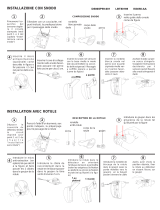 Elkron SP900/10 Guide d'installation
Elkron SP900/10 Guide d'installation
-
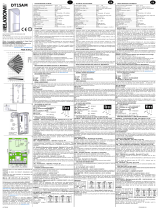 Elkron DT15AM Guide d'installation
Elkron DT15AM Guide d'installation
-
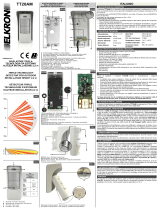 Elkron TT20AM Guide d'installation
Elkron TT20AM Guide d'installation
-
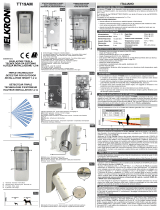 Elkron TT19AM Guide d'installation
Elkron TT19AM Guide d'installation
-
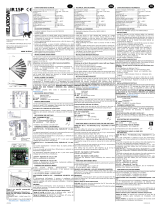 Elkron IR15P Guide d'installation
Elkron IR15P Guide d'installation
-
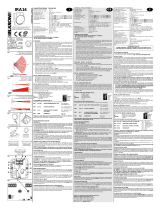 Elkron IRA 14 Guide d'installation
Elkron IRA 14 Guide d'installation
-
Risco WatchOUT Guide d'installation
-
Ksenia velum DT + AM User And Installer Manual
-
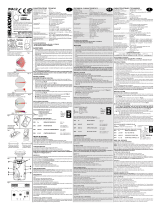 Elkron IMA 12 Guide d'installation
Elkron IMA 12 Guide d'installation
-
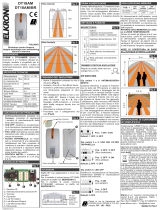 Elkron DT18AM Guide d'installation
Elkron DT18AM Guide d'installation









